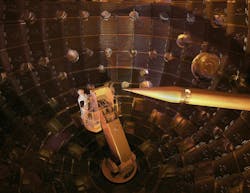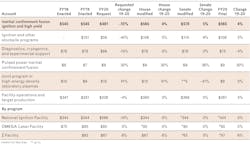Congress boosts inertial-confinement fusion budget; review results expected by end of FY20
The review is due by year’s end, more than a decade after the National Ignition Facility (NIF) began operation at the Lawrence Livermore National Laboratory (Livermore, CA). Years of testing and refinement were needed to reach the design goal of delivering 1.8 MJ, which theory had predicted would be enough to ignite fusion targets. In the end, the problem was not the laser, but the theory that had predicted ignition. Results of recent experiments are helping the review panel chart the future of inertial-confinement fusion.
By year’s end, the panel is to chart plans for a five-year program to increase NIF’s pulse energy and perform new experiments to either ignite a fusion plasma or pin down the conditions needed for ignition. NNSA, which oversees inertial fusion as part of its Stockpile Stewardship program, says the panel will analyze experimental, computer, and theoretical evidence to learn how fusion yields could be scaled to multimegajoule energies in the laboratory. That includes pinning down key physical uncertainties and projecting requirements for reaching ignition with the three major approaches under investigation: laser indirect drive fusion at NIF, laser direct drive with the OMEGA laser at the University of Rochester (Rochester, NY), and magnetic direct drive with the Z machine at Sandia National Laboratories (Albuquerque, NM). Their product is to be “a five-year road-map of specific milestones to address the physics, uncertainties, and performance findings.”
The reviewers are looking at all three approaches. Indirect drive is most studied approach, and x-ray-driven implosions with NIF have reached states where fusion self-heating, a key to achieving ignition, is beginning to occur. Other approaches have their own advantages. “In direct drive, all the laser energy goes on target rather than heating the hohlraum that makes the x-rays in indirect drive... We think that is an important advantage, but you have to do the physics right,” says Mike Campbell, director of Rochester’s Laboratory for Laser Energetics. NIF was originally designed to conduct direct- as well as indirect-drive tests, and Livermore and Rochester are using NIF as it stands now for important direct-drive experiments. Campbell hopes an upgraded NIF could test scaling of polar direct drive without a major rearrangement of the laser drive beams, as would be needed to test fully symmetric direct drive.
Improving NIF
Modifying NIF by redesigning some components and improving energy and power handling could increase pulse energy to 2.6 MJ, and raise peak power from the present 500 TW to 650 TW, says Siegfried Glenzer of the SLAC National Accelerator Laboratory (Menlo Park, CA), one of the reviewers. “The idea is that if you don’t get to ignition, then you would really understand what it would take to get ignition. Right now we don’t know that,” he says. Experimenters could also test new designs for pulse profiles and fusion targets.
Budget needs are under discussion. Glenzer says that technology-limited improvements could be completed within a year, but budget concerns might stretch the time needed.
Meanwhile, France, China, and Russia all have active inertial confinement fusion programs. The French Laser Megajoule system is based on the NIF design, and like NIF is managed by the military arm of the country’s atomic energy agency. Construction is proceeding slowly. Although officially commissioned in October 2014, only 56 of the planned 176 beams were expected to be finished in 2019, for a peak energy of 250 kJ.
The Chinese Academy of Engineering Physics operates the Research Center of Laser Fusion in Mianyang, Sichuan (China) with the world’s second-largest operational fusion laser, called Shenguang (divine light) III, with 48 beams and higher energy than OMEGA. Like NIF, it is designed for indirect-drive fusion. “They publish a lot,” says Campbell, and have ambitions plans, including building another NIF-like laser called Shenguang IV, along with a direct-drive laser and a pulsed power system.
Little technical information has emerged from the current Russian laser fusion program, but a Pravda report posted on YouTube in April 2019 claims that the Research Institute of Experimental Physics (Sarov, Russia) has built a target chamber for fusion implosion experiments with a 2.8 MJ green laser. Current indications are that it will begin experiments in the first half of this decade.
About the Author
Jeff Hecht
Contributing Editor
Jeff Hecht is a regular contributing editor to Laser Focus World and has been covering the laser industry for 35 years. A prolific book author, Jeff's published works include “Understanding Fiber Optics,” “Understanding Lasers,” “The Laser Guidebook,” and “Beam Weapons: The Next Arms Race.” He also has written books on the histories of lasers and fiber optics, including “City of Light: The Story of Fiber Optics,” and “Beam: The Race to Make the Laser.” Find out more at jeffhecht.com.


